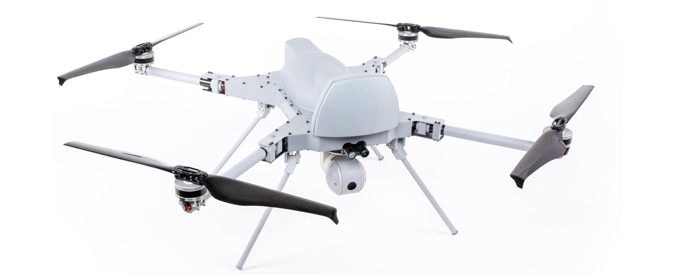2021-08-01
DRONES.. A Revolution in Quantum Military Affairs?
The Impact of Emerging Technologies on 21st Century Defense Strategy
By: Patrick Bell
Secure battlefield communications invulnerable to hackers. Systems correctly identifying armoured targets with 98 or 99 per cent efficiency at a recent exercise. (Cox 2021). Swarms of drones launching a coordinated attack on opposing forces in the Russo-Ukrainian conflict without human intervention.
Each of these scenarios are within reach for nation-states employing systems using a combination of quantum computing and machine learning referred to as Quantum Artificial Intelligence (QAI).
Each of these scenarios also reveals the impact of cutting-edge technologies on 21st Century Defense Strategy. Specifically, that defense strategies will have to be revised to address three areas that taken together can be referred to as “quantum warfare” (Krelina 2021). These areas include new capabilities, and increased effectiveness and precision.
Though technology has always sought to improve these three areas, cutting-edge technologies in the 21st century are qualitatively different in that they incorporate aspects of the fourth industrial revolution. Where there is a “Fusion of technologies that is blurring the lines between the physical, biological and technical spheres” (Schwab 2012) . This trend can be seen not just in computing but also in other areas including lethal autonomous weapons (Scharre 2018) and synthetic biology (Gronvall 2018) . Together these technologies have ushered in what may be called a “Revolution in Quantum Military Affairs (Wendt 2020).
The key to understanding each of these scenarios lies in understanding the components of the “spooky action at a distance” investigated beginning in the 1920s by scientists such as Albert Einstein (Wendt 2020). Specifically, from a strategic standpoint, human decision making must take into account the increasing volume, velocity and variety of threats emergent from this latest revolution in military affairs.
To address the impact of this latest revolution, strategic decision makers must understand first that the time between decision and action is rapidly closing. Decision makers have less time to make a decision and yet have more data to analyse. This data as well as the programmes used to analyse it must be programed to avoid inherent biases as the time to make a decision becomes shorter.
Next strategic decision makers must take into account that challenges and threats are merging and emergent phenomena are becoming more prevalent. One example of this in the “dual use nature” of quantum technology. The same technology that can be used to create secure, unhackable communications can be used to break the traditional public key encryption that underlies most military communications. Using the exponentially increasing speed of a quantum computers, current cryptographic techniques like public key encryption will be vulnerable thus necessitating the creation of Quantum cryptography.
The impact of emerging technology on military strategy can already be seen in the statement of the U.S. Defense Secretary Lloyd Austin in recent statements at the Indo-Pacific Command (INDOPAC) change of command ceremony on 30 April 2021:
“It means developing new operational concepts for things we already have. And it means investing in quantum computing and other cutting-edge capabilities for the future, all domains. Think of AI, which will help us make decisions with more speed and rigour.” (Austin 2021).
The same pattern can be seen in other areas of emerging technology, where information warfare techniques are applied to social media in the form of social lasing. “Social Lasing” refers to the amplification of social action ( i.e. protests) through distribution of specific content on social networks where individuals interact heavily in exchanging messages on a topic that is designed to promote a specific narrative. By introducing specific narratives through messaging on a social network, a state or non-state actors can induce polarisation in the target community thus destabilising their adversary or enemies information environment. (Tsarev, Trofimova and Khrennikov 2019). The application of this technique is based on the principles of quantum information theory which uses quantum mechanics to model how information flows through a network (Khrennikov 2020). An example of this can be seen in 2016 and 2020 U.S. Presidential Elections.
Thirdly, there is the re-emerging possibility of biological threats brought about by the misuse of synthetic biology. Advances in this area have progressed to the point where it is no longer necessary to acquire a pathogen such as small pox from a lab. It can be created can be made ‘from scratch’ (Gronvall 2018).
What each of these emerging threats reveals is that a new mind set is required to deal with the interactions of these challenges and threats. Among the key implications is that military strategy must develop a new method for assessing risk that takes into account the key components of these emergent threats.
But how can this be accomplished? This first step lies in applying a model based on so called “Quantum Risk Analysis” (Woerner 2019) to the four traditional stages of risk assessment. Risk recognition, risk identification, risk analysis, and risk evaluation. Application of this so called “Quantum Risk Analysis” has already been applied to international financial systems and could be adapted to the impact of emerging technologies on military strategy.
Moreover, applying a model of quantum risk evaluation to national security policy will make risk calculation more precise since it allows for a dynamic updating of risk probabilities. Thus an entire series of possible events (i.e. compliance, compellence, deterrence) can be considered when making a decision as to the level of risk presented by a state or non-state actors. By leveraging these emerging technologies decision making can be more agile and flexible and turn the challenge of these emerging technologies into an opportunity.


No Comments